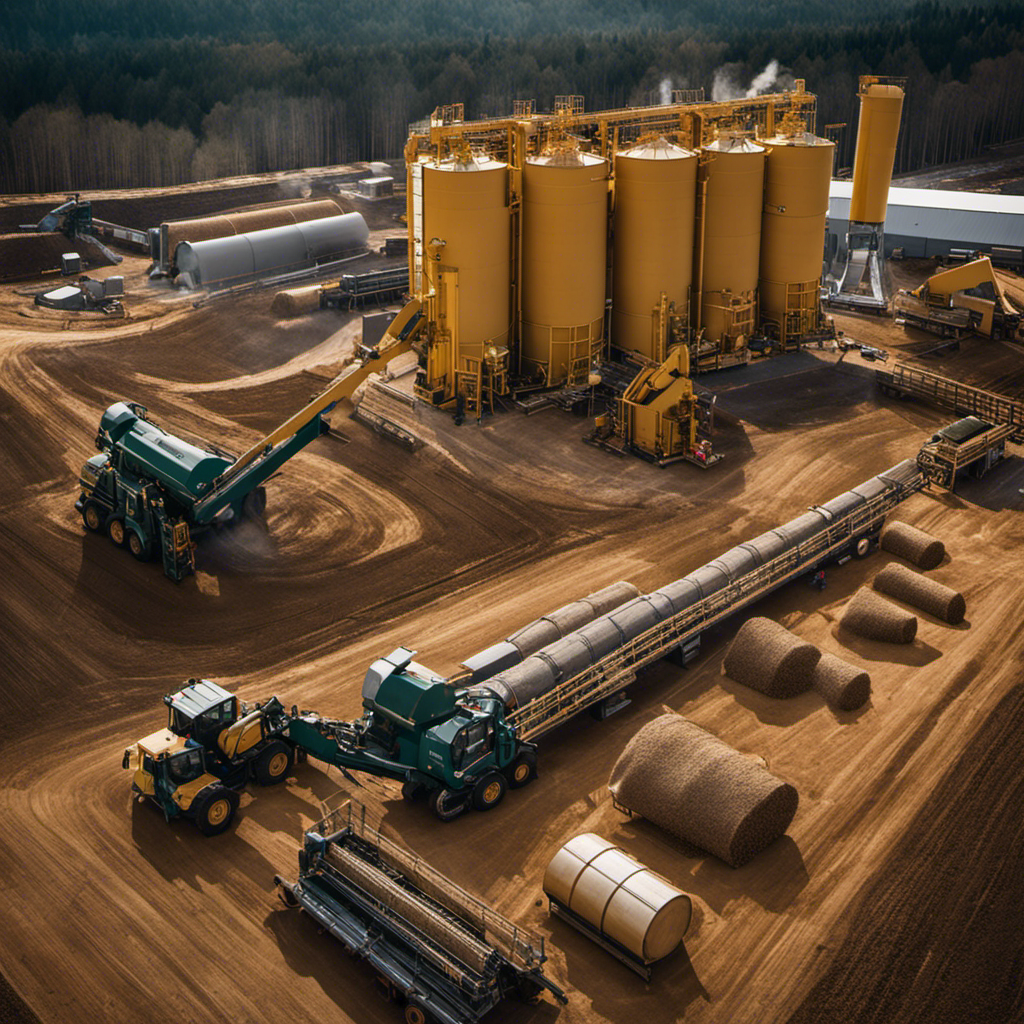The production process of wood pellets has continually fascinated me. Observing the machinery buzz and spin, the careful handling of materials, and the detailed procedure of pellet creation is akin to watching an efficiently orchestrated symphony.
In this article, we’ll delve into what a wood pellet operation looks like when running on line. From quality control to packaging and storage, we’ll explore every aspect of this environmentally-friendly production process.
So sit back, relax, and let’s dive into the fascinating world of wood pellet production.
Key Takeaways
- Equipment and machinery, such as a hammer mill, pellet mill, cooler, and packaging machine, are essential for a wood pellet operation to run efficiently.
- Careful sorting and preparation of raw materials, including sourcing high-quality materials and reducing moisture content, are crucial for consistent pellet production.
- The pelletizing process involves grinding wood into particles and using extrusion technology to shape them into uniform pellets with precise density and moisture content.
- Quality control measures and testing protocols ensure the integrity and high quality of wood pellets, including factors like moisture content, density, durability, and ash content.
Equipment and Machinery Used in a Wood Pellet Operation
When running a wood pellet operation, you’ll typically use equipment and machinery such as a hammer mill, pellet mill, cooler, and packaging machine. These tools are essential for ensuring the production of high-quality pellets.
To maintain excellent pellet quality, regular equipment maintenance is crucial. The hammer mill plays a vital role in grinding raw materials into smaller particles before they enter the pellet mill. Proper maintenance of the hammer mill ensures optimal performance and reduces downtime.
The pellet mill itself is responsible for compressing the ground material into dense pellets. Regular inspection and lubrication of its components guarantee efficient operation and consistent pellet quality.
Afterward, the cooler helps cool down the hot pellets to prevent moisture accumulation and ensure long-term storage stability. Lastly, the packaging machine securely packages the finished pellets, ready for distribution.
Moving on to raw materials and their preparation…
Raw Materials and Their Preparation
To properly prepare the raw materials, you’ll need to carefully sort and grind them before they can be used in your wood pellet operation. Raw material sourcing is a crucial aspect of running a successful wood pellet operation. The quality and consistency of the raw materials directly impact the final product. It is essential to source high-quality raw materials such as sawdust, wood chips, or agricultural residues from reliable suppliers.
Once you have obtained the raw materials, they need to go through a drying process to reduce their moisture content. This ensures that the pellets produced will have optimal combustion properties and prevent any potential issues during storage or transportation. After sorting and drying, the next step in the wood pellet production process is grinding.
The transition into the subsequent section about the pelletizing process: from grinding to extrusion could be made by mentioning that once the raw materials are ground down to a specific size, they are ready for further processing in order to form pellets with consistent density and shape.
The Pelletizing Process: From Grinding to Extrusion
When it comes to the pelletizing process, there are three key points to consider.
First, grinding wood into particles is a crucial step. This helps to increase the surface area and improve the efficiency of pellet production.
Next, extrusion is used to shape these ground particles into pellets. This is done by applying pressure and heat.
Grinding Wood Into Particles
As you grind the wood into particles, make sure to wear protective gear and keep a safe distance from the machine. Grinding is a crucial step in the wood pellet production process, as it helps to break down large pieces of wood into smaller particles that can be formed into pellets. This process not only ensures uniformity in particle size but also increases the surface area for better combustion efficiency. In terms of economic viability, grinding plays a significant role in reducing transportation costs by compacting the material. To give you an idea of the particle sizes obtained during this process, refer to the following table:
| Particle Size | Description |
|---|---|
| Fine | Smaller than 3 mm |
| Medium | Between 3-6 mm |
| Coarse | Larger than 6 mm |
Once we have achieved the desired particle size, we can move on to forming pellets through extrusion.
Forming pellets through extrusion
Forming Pellets Through Extrusion
Once the desired particle size is achieved, we can proceed to form pellets through extrusion.
Extrusion technology plays a crucial role in the wood pellet production process. It involves forcing the finely ground wood particles through a die with small holes to create cylindrical pellets of uniform shape and size.
The benefits of using extrusion technology are numerous. Firstly, it allows for precise control over the pellet density, which directly impacts its combustion efficiency and energy output.
Secondly, it ensures consistent moisture content throughout the pellets, preventing clumping or disintegration during storage and transportation.
Lastly, extrusion enhances the durability of wood pellets by compressing them under high pressure, resulting in a denser and more compact final product.
With the formation of pellets complete, let’s now delve into the subsequent section about the steps in the pelletizing process without further delay.
Steps in Pelletizing Process
To begin the pelletizing process, we need to prepare the raw materials by grinding them into a fine powder. Once the material is ground, it is ready for pelletization. There are several pelletizing techniques that can be used, including extrusion and rotary drum methods. Each technique has its own advantages and disadvantages in terms of efficiency, cost, and pellet quality control.
| Pelletizing Technique | Advantages | Disadvantages |
|---|---|---|
| Extrusion | High capacity production | Limited to certain materials |
| Rotary Drum | Versatile for various materials | Lower production capacity |
Pellet quality control is crucial to ensure that the final product meets the desired specifications. This involves monitoring factors such as moisture content, particle size distribution, and density. Quality control procedures may include regular sampling and testing of pellets to assess their physical properties and performance.
As we move into discussing quality control and testing procedures in the next section, it’s important to understand how these steps contribute to producing high-quality wood pellets without compromising on efficiency or cost-effectiveness.
Quality Control and Testing Procedures
You need to ensure that quality control and testing procedures are in place for a wood pellet operation running online. Quality control procedures play a crucial role in maintaining the integrity and consistency of wood pellets produced. This involves implementing strict standards and protocols throughout the production process.
Testing protocols should be established to assess the quality of raw materials, such as moisture content, particle size distribution, and calorific value. Additionally, regular testing should be conducted on the finished product to ensure it meets the required specifications for moisture content, density, durability, and ash content. By implementing these quality control measures and rigorous testing procedures, you can guarantee that your wood pellet operation produces high-quality pellets consistently.
With this foundation in place, we can now move on to discussing the packaging and storage of wood pellets.
Packaging and Storage of Wood Pellets
Now that we have established the importance of quality control and testing procedures, let’s delve into the topic of packaging and storage for wood pellets.
Packaging Techniques:
- Bagging: Wood pellets are commonly packaged in bags made from durable materials such as plastic or woven polypropylene. These bags protect the pellets from moisture and ensure convenient handling.
- Bulk Delivery: For larger scale operations, wood pellets can be transported in bulk using specialized tanker trucks or railcars. This method eliminates the need for individual bagging and allows for efficient loading and unloading.
Pellet Storage Methods:
- Indoor Storage: Wood pellets are often stored indoors in dedicated silos or bins. These structures provide protection from weather elements and minimize pellet degradation due to exposure.
- Outdoor Storage: Some facilities opt for outdoor storage solutions like covered storage yards or tarps to protect the pellets while optimizing space utilization.
Considering these packaging techniques and pellet storage methods, it is essential to also take environmental considerations into account during wood pellet production.
Environmental Considerations in Wood Pellet Production
When it comes to the production of wood pellets, two key considerations are carbon emissions reduction and sustainable forest management.
Carbon emissions reduction is crucial in mitigating climate change and achieving environmental sustainability. By using wood pellets as a renewable energy source, we can significantly reduce carbon emissions compared to fossil fuels like coal or oil.
Additionally, sustainable forest management ensures that the forests from which wood pellets are derived are responsibly managed and regenerated, promoting biodiversity and long-term ecological health.
Carbon Emissions Reduction
The carbon emissions are significantly reduced when a wood pellet operation is running online. Wood pellets are considered a renewable energy source, as they are made from sustainably sourced wood and can be continuously produced. The process of producing wood pellets involves grinding and compressing wood waste into small pellets, which can then be burned for heat or electricity generation. Compared to fossil fuels, wood pellets emit lower levels of carbon dioxide when burned. In fact, wood pellet production is often seen as a form of carbon offsetting, as the trees used to make the pellets absorb CO2 during their growth cycle. This table illustrates the carbon emissions reduction potential of a typical wood pellet operation:
| Activity | Emissions Reduction Potential |
|---|---|
| Fossil fuel substitution | High |
| Biomass feedstock | Moderate |
| Pellet production | Moderate |
| Transport | Low |
| Combustion | High |
By utilizing sustainable forest management practices, we can ensure that the trees used for wood pellet production are replanted and regrown, further enhancing the environmental benefits of this renewable energy source.
Next in line: ‘Sustainable Forest Management’
Sustainable Forest Management
Utilizing sustainable forest management practices ensures that trees can be replanted and regrown, enhancing the environmental benefits of wood pellet production. This approach not only protects our forests but also offers several economic advantages.
Here are some key points about sustainable sourcing and its economic benefits:
- Sustainable forest management promotes responsible harvesting, ensuring a continuous supply of timber for wood pellet production.
- It helps preserve biodiversity by maintaining the health of ecosystems and protecting wildlife habitats.
- By reducing deforestation and promoting reforestation, sustainable sourcing contributes to carbon sequestration, mitigating climate change impacts.
- Wood pellet operations that prioritize sustainable sourcing often benefit from government incentives and certifications, attracting environmentally conscious consumers.
By adopting these practices, wood pellet producers can secure a reliable source of raw materials while contributing positively to the environment.
Now let’s explore how maintenance and troubleshooting play a crucial role in ensuring smooth operations in a wood pellet facility.
Maintenance and Troubleshooting in a Wood Pellet Operation
Maintenance and troubleshooting are essential aspects of running a wood pellet operation smoothly and efficiently. To ensure optimal performance, regular maintenance techniques should be implemented.
This includes inspecting and cleaning the equipment, such as the pellet mill, dryer, and conveyors, to prevent any potential blockages or malfunctions. Lubrication of moving parts is also crucial to reduce friction and enhance longevity.
Additionally, monitoring the quality of raw materials is vital to prevent issues during the production process. Troubleshooting tips involve identifying common problems like inconsistent pellet size or low production rates, and addressing them promptly through adjustments in temperature, feed rate, or die pressure.
By practicing effective maintenance techniques and employing troubleshooting strategies, operators can minimize downtime and maximize productivity in their wood pellet operation.
To optimize efficiency and productivity in a wood pellet operation requires careful attention to various factors…
Optimizing Efficiency and Productivity in a Wood Pellet Operation
To optimize efficiency and productivity in a wood pellet operation, it is crucial for operators to implement effective maintenance techniques and troubleshooting strategies. By doing so, operators can ensure that the operation runs smoothly and efficiently, minimizing downtime and maximizing production output.
One key aspect of efficiency improvement is regular equipment maintenance. This includes routine inspections, cleaning, and lubrication of machinery to prevent breakdowns and reduce the risk of costly repairs. Implementing a proactive approach to troubleshooting can help identify and address issues before they escalate into major problems.
Another important factor in production optimization is streamlining processes. This involves analyzing workflows, identifying bottlenecks or inefficiencies, and making necessary adjustments to improve overall productivity. It may also involve utilizing automation technology or upgrading equipment to enhance efficiency further.
Frequently Asked Questions
What Are the Typical Energy Consumption Rates for a Wood Pellet Operation?
Typical energy consumption rates for a wood pellet operation depend on factors such as production capacity and equipment efficiency. Conducting a cost analysis can help determine energy efficiency measures to minimize consumption and reduce operational costs.
How Long Does It Take for Wood Pellets to Fully Dry Before They Can Be Processed?
When wood pellets are fully dry, they can be processed. The drying time depends on factors like moisture content and drying techniques used. It’s crucial to ensure proper drying before processing for optimal results.
What Are the Most Common Challenges Faced During the Pelletizing Process?
During the pelletizing process, common challenges include inconsistent moisture levels in the raw material, equipment breakdowns, and maintaining consistent pellet quality. Improvements can be made through better monitoring systems and regular maintenance.
Are There Any Specific Safety Measures That Need to Be Taken During Packaging and Storage of Wood Pellets?
When it comes to packaging safety and storage precautions for wood pellets, it’s crucial to follow proper procedures. Ensuring secure packaging and storing in appropriate conditions helps prevent accidents and maintain the quality of the pellets.
What Are the Potential Environmental Impacts of Wood Pellet Production and How Can They Be Mitigated?
Potential solutions for mitigating the environmental impacts of wood pellet production include implementing sustainable practices like sourcing from responsibly managed forests, using efficient machinery, and reducing energy consumption throughout the operation.
Conclusion
In conclusion, operating a wood pellet operation requires careful planning and attention to detail. From the equipment and machinery used to the raw materials prepared, each step in the process contributes to producing high-quality wood pellets.
One interesting statistic that highlights the significance of this industry is that wood pellet production has increased by over 40% globally in the past decade, reaching an astonishing 35 million metric tons in 2020. This growth showcases the growing demand for renewable energy sources and emphasizes the importance of efficient and sustainable wood pellet operations.











